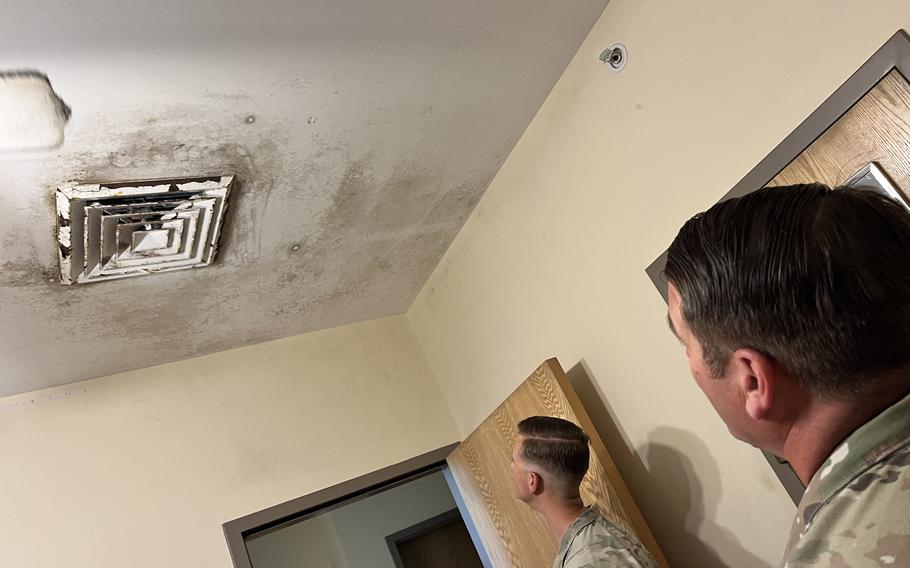
Military leaders do a walk-through of facilities at Fort Stewart and Hunter Army Airfield, Ga., after soldiers voiced concerns and posted imagery of mold in rooms on social media. A Government Accountability Office report cited numerous deficiencies in living accommodations at stateside bases. (U.S. Army)
Barracks life can mean enduring raw sewage overflows, dangerous gas leaks and rodent infestations, according to a new government report saying military officials don’t have a full grasp of the squalor thousands of troops face.
U.S. service members also could be at increased risk of sexual assault and other crimes because of chronically broken windows and locks, the Government Accountability Office said Tuesday in a report based on a visit to 10 stateside military bases.
“At one installation, we noticed a bad odor throughout the barracks. Installation officials told us the smell was methane gas leaking out of aging plumbing with sewage pipes that routinely crack and require replacement,” the GAO said, citing one example of the problems it found during a tour of installations.
The Defense Department service branches have come under intense scrutiny because of the poor living conditions some troops face. Over the past couple of years, there have been high-profile scandals at several locations.
In 2022, for example, a mold infestation at Fort Liberty, N.C., forced 1,200 soldiers out of barracks. The buildings were demolished upon their evacuation.

Workers remove carpet from a dorm room impacted by mold Aug. 1, 2019, at Joint Base San Antonio-Lackland, Texas. A Government Accountability Office reported observed barracks at seven of 10 military installations visited that required significant improvements. (U.S. Army)
While there is a general awareness of the problems with base housing, military officials could be underestimating the extent of the barracks crisis because of a rating system that gives passing grades to facilities that are clearly substandard, GAO said.
“DOD doesn’t have reliable information about barracks conditions, or how these conditions affect troop morale,” the GAO said. “And while DOD spends billions of dollars annually on its facilities, it’s unable to identify how much funding goes toward barracks.”
Still, the military doesn’t appear to have a clear strategy for rectifying the problem, which could be causing people to flee the services, the GAO said.
“No military service has fulfilled DOD requirements to periodically evaluate the effects of barracks conditions on service members’ reenlistment decisions,” the GAO said.
The GAO said it observed barracks at seven of 10 military installations visited that required significant improvements, despite positive “condition scores” of 80 and above.
In one case, an unnamed barracks had to be shut down because of plumbing and electrical issues. Yet that base had a score of 90, indicating the building was in excellent condition, the GAO said.
Also, the barracks scrutinized by observers “pose potentially serious health and safety risks” and do not meet minimum DOD standards for privacy and configuration, according to the report.
In discussions with service members living in barracks and their senior enlisted leaders, the GAO was told that such conditions “contributed to an environment where theft, property damage, and sexual assault were more likely.”
In all 12 troop discussion groups at the bases visited, there was a consensus that rundown barracks had a negative effect on mental health, the GAO said.
“For example, in one group, a service member told us about increased anxiety and panic attacks after living in the barracks,” the GAO said. “In another, a service member said it was depressing to come home to a dark box after work.”
Among the obstacles to improving conditions is a DOD lack of complete funding information to make informed decisions and it conducts insufficient oversight.
The report recommended that the DOD and its service branches put in place an array of bureaucratic reforms to better track barracks conditions and the assessments of service members who reside in them.
DOD concurred with 23 of the 31 recommendations and partially concurred with eight others. The GAO countered that DOD should comply with all the recommendations.
The bases visited by the GAO were: Fort Meade, Md.; Fort Carson, Colo.; Joint Base Andrews-Naval Air Facility Washington; Joint Base San Antonio; Naval Support Activity Bethesda, Md.; Naval Base Coronado and Naval Base San Diego in California; Marine Corps Base Quantico, Va.; Marine Corps Recruit Depot San Diego; and Camp Pendleton, Calif.